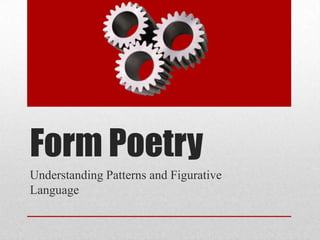
Forms of poetry
- 1. Form Poetry Understanding Patterns and Figurative Language
- 2. • Refers to various sets of “rules” of certain types of poetry • The rules may regard rhythm, meter, rhyme scheme, or alliteration • Examples: Sonnets, sestinas, haiku, epic, blank verse Poetic Form
- 3. • Discuss this poem as a group. What do you notice about the form? What does the form of the poem do to enhance the meaning? • What is the difference between the world depicted on the urn and the speaker’s world? Which world does the speaker seem to prefer? • How would you recognize this poem as an “ode” besides referring to the title? John Keats’ “Ode on a Grecian Urn” p. 825
- 4. • There are many types of poems. • Most emerged during the Renaissance period, due to a change in the way language was being employed • During this class, we will only go over a few of the major types of form Types of Poems
- 5. • A fixed form of lyric poetry that consists of 14 lines • Usually written in iambic pentameter—which consists of one unstressed syllable, followed by one stressed syllable (“away”). • The Italian Sonnet is divided into an octave, which typically rhymes abbaabba and a sestet, which may vary in rhyme. • The English sonnet is organized into three quatrains and a couplet, which rhyme abab cdcd efef gg. • Example p. 976 Shakespeare’s “Shall I compare thee to a summer’s day?” Sonnet
- 6. • A style of lyric poetry borrowed from the Japanese that typically presents an intense emotion or vivid image of nature, which is designed to a spiritual insight. • Contains seventeen syllables organized into three unrhymed lines of 5, 7, 5 syllables. • A reversed haiku/inside-out haiku has 7, 5, 7 syllables in each line. • Example: p. 989 Haiku
- 7. • A long narrative poem. • Uses formal, elevated language that focuses on a serious subject and chronicles heroic deeds and events • Example: Milton’s Paradise Lost Epic
- 8. • A ballad is usually sung. • It began as a song and then was written down to tell a story. • Ballads are typically dramatic, condensed, and impersonal narratives. Ballad
- 9. • Unrhymed iambic pentameter (away) • This is the English Verse form closest to the natural rhythms of English speech and it is the most common pattern found in traditional English narrative and dramatic poetry. Blank Verse
- 10. • A light and humorous form. • Usually consists of 5 predominantly anapestic lines rhyming aabba. • Lines 1, 2, and 5 contain three feet, while lines 3 and 4 contain 2. • Example: p. 987 Limerick
- 11. • Type of form poetry consisting of 19 lines of any length divided into 6 stanzas: 5 tercets and a concluding quatrain. • The first and third lines of the initial tercet rhyme are repeated in each subsequent tercet (aba) and in the final two lines of the quatrain abaa. • Example: p. 981 Dylan Thomas, “Do Not Go Gentle into That Good Night” Villanelle
- 12. • Sometimes called free verse. • Does not conform to established patterns of meter, rhyme, and stanza. • Example: ee cummings Open Form
- 13. • A type of form poetry consisting of 36 lines of any length divided into 6 sestets and a three-line concluding stanza called an envoi. • The six words at the end of the first sestet’s lines must also appear at the ends of the five other sestet’s in varying order. • The six words also appear in the envoi. Sestina
- 14. • Write a short response to this poem. • Is this in form? What is the effect of the rhyme scheme? • What is the tone? • In what sense might this celebration of oxygen be considered a love poem? Mary Oliver’s “Oxygen” p. 823
- 15. • Group #1: Gwendolyn Brooks’ “We Real Cool,” p. 827 • Group #2: Alice Jones’ “The Larynx,” p. 828 • Group #3: Molly Peacock’s “Desire,” p. 979 • Group #4: Brendan Galvin’s “An Evel Knievel Elegy,” p. 991 • Discuss the effect of the rhyme scheme on the way you read and understand the poem • What are the limits of form? What are the advantages? Group Discussion
